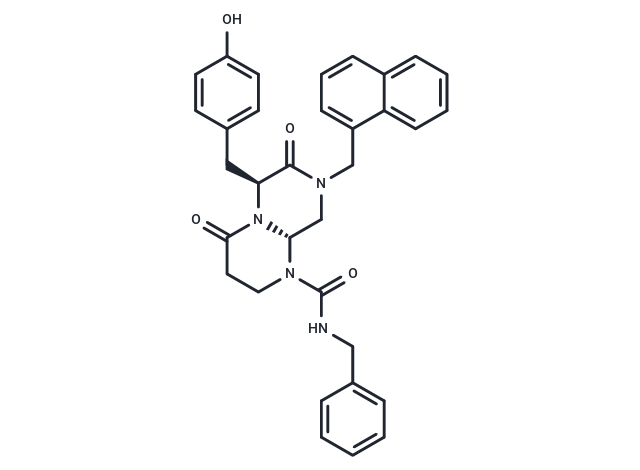Shopping Cart
- Remove All
 Your shopping cart is currently empty
Your shopping cart is currently empty

ICG001 antagonizes Wnt/β-catenin/TCF-mediated transcription and specifically binds to element-binding protein (CREB)-binding protein (CBP) with IC50 of 3 μM, but is not the related transcriptional coactivator p300.

| Pack Size | Price | Availability | Quantity |
|---|---|---|---|
| 1 mg | $30 | In Stock | |
| 5 mg | $64 | In Stock | |
| 10 mg | $108 | In Stock | |
| 25 mg | $218 | In Stock | |
| 50 mg | $379 | In Stock | |
| 100 mg | $588 | In Stock | |
| 500 mg | $1,260 | In Stock | |
| 1 mL x 10 mM (in DMSO) | $78 | In Stock |
| Description | ICG001 antagonizes Wnt/β-catenin/TCF-mediated transcription and specifically binds to element-binding protein (CREB)-binding protein (CBP) with IC50 of 3 μM, but is not the related transcriptional coactivator p300. |
| Targets&IC50 | CBP:3 μM |
| In vitro | ICG001 binds specifically to CBP but not the related transcriptional coactivator p300, thereby disrupting the interaction of CBP with β-catenin. Treatment with ICG001 selectively induces apoptosis in colon carcinoma cells but not in normal colonic epithelial cells and reduces in vitro growth of colon carcinoma cells[1][2]. |
| In vivo | ICG001 exhibits antitumor activity in the mouse xenograft models of colon cancer. The initial results of the Phase I clinic trial of ICG001 has been disclosed publically. The drug exhibits an acceptable toxicity profile with only one dose-limiting toxicity of grade 3 reversible hyperbilirubinaemia. An Open-Label dose-escalation phase I/II study of ICG001 for patients with advanced myeloid malignancies is still ongoing[2]. |
| Cell Research | ICG-001 is dissolved in DMSO. To evaluate effects of ICG-001 on α-SMA and collagen type 1 expression, RLE-6TN cells are treated with TGF-β1 (0.25 ng/mL) in the presence or absence of ICG-001 (5.0 μM). After 24 h, cells are harvested and mRNA isolated for analysis by qPCR. RNA is reverse-transcribed using SuperScript reverse transcriptase. Quantitative PCR is performed with SYBR-Green PCR using Real-Time PCR System HT7900. The amplification protocol is set as follows: 95°C denaturation for 10 min followed by 40 cycles of 15-s denaturation at 95°C, 1 min of annealing/extension, and data collection at 60°C. |
| Molecular Weight | 548.63 |
| Formula | C33H32N4O4 |
| Cas No. | 847591-62-2 |
| Smiles | Oc1ccc(C[C@@H]2N3[C@H](CN(Cc4cccc5ccccc45)C2=O)N(CCC3=O)C(=O)NCc2ccccc2)cc1 |
| Relative Density. | 1.37 g/cm3 |
| Storage | Powder: -20°C for 3 years | In solvent: -80°C for 1 year | Shipping with blue ice. | |||||||||||||||||||||||||||||||||||
| Solubility Information | DMSO: 40 mg/mL (72.91 mM), Sonication is recommended. Ethanol: 27.4 mg/mL (49.94 mM), Sonication is recommended. | |||||||||||||||||||||||||||||||||||
Solution Preparation Table | ||||||||||||||||||||||||||||||||||||
Ethanol/DMSO
DMSO
| ||||||||||||||||||||||||||||||||||||

Copyright © 2015-2025 TargetMol Chemicals Inc. All Rights Reserved.